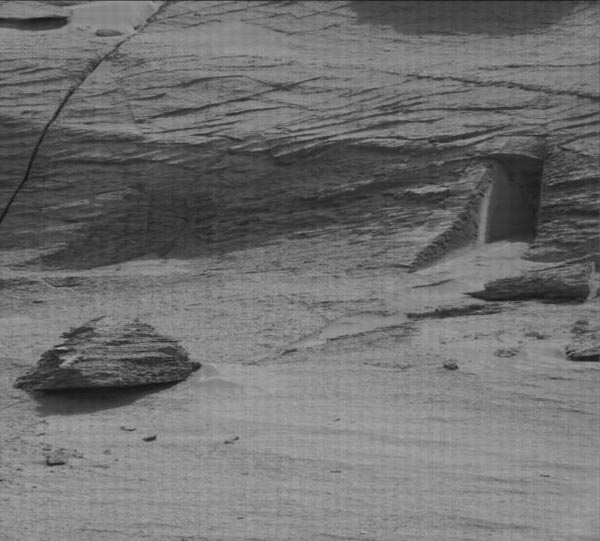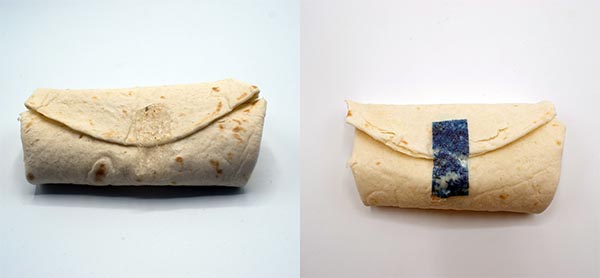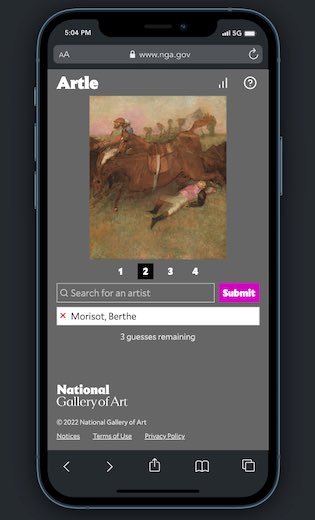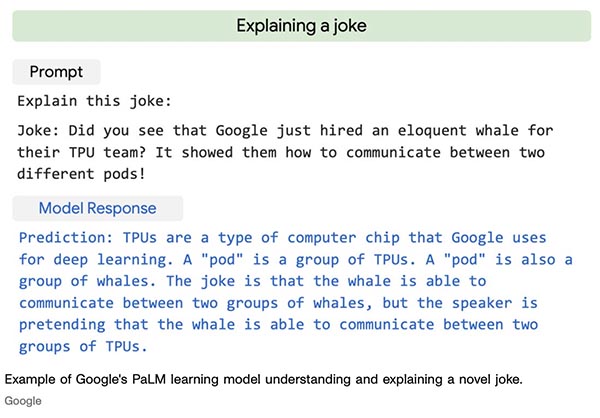Your Friday Disconcertingly Disembodied Robotic Mouth Singing Endless AI-Generated Self-Learning Prayers
The Perception of Doors
You may have seen the recent photo sent back by the Mars Curiosity rover that showed what looked like a doorway on the surface of Mars.

Image credit: NASA/JPL-Caltech/MSSS
And of course the Internet did what it does, but scientists were quick to point out that it is not a doorway. Says LiveScience:
Several clues make it clear that the subject of the image is not an actual door: For a start, it's less than 3 feet (1 meters) high, planetary geologist Nicholas Mangold of the University of Nantes in France told Live Science in an email.
True—the face on Mars could never fit through it.
...tongue-in-cheek suggestions from the internet included the idea that it is the space tomb of Jesus; a crib for E.T.; or a save-point for a video game, the Vice website reported.
But the real answer is that it's none of those things. Instead, what looks like a door is in fact a shallow opening in the rock that's almost certainly caused by natural forces, say the experts.
Those natural forces being essentially erosion caused by Martian winds.
Several natural vertical fractures are also visible in the image, among them fractures caused by the way rocks weather on Mars; and the small cave or "door" seems to have formed where the vertical fractures intersect with the strata, he said.
Ad Nauseam
One of the advantages of streaming services is—at least for now—no ad breaks. Now, mind you, for those who grew up on network television, the commercial break was an accepted evil. It was only after they got longer and longer and more frequent that it got annoying. Consider that, in the late 1960s, the average length of an hour-long drama was about 52 minutes (8 minutes of commercials) and a half-hour sitcom was 26 minutes (four minutes of commercials). Today, an hour-long show is 42 minutes long (18 minutes of commercials) and a half-hour sitcom is 21 minutes (9 minutes of commercials). If you watch movies on basic cable it’s even more brutal to the point of being unwatchable.
In our limited experience of ad-based streaming (early Hulu), it wasn’t so much the presence of ads per se that was offputting, but the placement of them. Broadcast TV shows are literally written around ad breaks—they function as act breaks, and thus the ads come at logical breaking points in the story. Ads on streaming services are thrown in at random, often in the middle of a line of dialogue, which completely ruins the watching experience. (It may have gotten better since then, but the prime offender now is YouTube, which just throws in ads whenever it likes.)
There has always been a more subtle (well, usually) version of TV and movie advertising than outright ads, and that has been product placement. A character uses an Apple computer, another drinks a Coke, or there are visible billboards in a shot advertising a company or product (watch any of the late-70s Roger Moore Bond movies for some of the most laughably egregious examples of this). However, an article in Marketing Brew pointed out that product placement may be venturing into new territory.
In what feels like something out of a science-fiction film, advertisers are using technology to digitally insert themselves into television shows after filming has wrapped to make up for lighter ad breaks on streaming services.
“All of a sudden, the 15 minutes of ads that they used to have on national television [or] cable is no longer an acceptable experience for viewers,” Andrew King, VP of product at ad-tech firm TripleLift, told Marketing Brew.
Basically, it’s the same kind of technology that let Forest Gump be placed into historical footage—it can integrate brands into shows after the fact.
Though details were sparse, Amazon’s Virtual Product Placement tool, still in beta, is being used in a slate of Amazon Originals, including the Bosch franchise and Tom Clancy’s Jack Ryan.
In a test with GroupM, M&Ms saw a 6.9% increase in brand favorability and a 14.7% increase in purchase intent, according to an Amazon spokesperson. It’s also only available for titles set in contemporary periods, and not kids’ content. So, no, Don Draper won’t be chugging a White Claw. Yet.
We wonder what showrunners make of this and how much control they will have over the process. Subtle, organic product placement is fine, but when it becomes laughably egregious and takes viewers out of the story, then it becomes unwatchable.
Throwing Shade
Here’s a literally cool idea, via Core77: a thermobimetal system that results in self-shading windows without a remote—or even any kind of energy input at all, except from the sun.
Bimetallic sheets or strips are nothing new—they’ve been used in thermostats for decades, for example. Basically, they consist of two different metals or metal composites attached to each other in a sheet or strip. The two metals chosen have different rates of thermal expansion so that when they are exposed to heat, they curl, as one of the metals expands faster than the other. So, the idea that architect Doris Sung had was to “create a grid of thermobimetal pieces, then sandwich them inside ordinary double-glazed windows.” Thus, when sunlight hits the window and the metals heat up, they curl in such a way as to shade the window. This keeps a room cooler, potentially reducing cooling costs, especially in commercial buildings.
Sung has formed TBM Designs to commercialize the technology.
Graphene Doesn’t Hold Water
Was it a good week for graphene news? It’s always a good week for graphene news! Researchers discover water-repellent graphene. Says Graphene-Info:
Researchers at the Harvey Mudd College
This is not to be confused with Harry Mudd College. We continue.
in the U.S have made an unexpected discovery that holds exciting potential for creating robust water-repellent coatings using gas-phase-synthesized graphene (GSG) and other nanomaterials.
Last summer, the researchers were working on two projects: A National Science Foundation-funded project characterizing nanocomposites and a project supported by the College’s Rasmussen Summer Research fund that involved using graphene to separate oil from water. “While working on these projects, the students discovered that water droplets falling on our graphene powder were easily sliding off and bouncing from it,” says Albert Dato, author of the paper. “This was a completely unexpected result since we weren’t even looking into this phenomenon called superhydrophobicity.”
This is not to be confused with the song from Mary Poppins. We continue.
With the goal of testing the hypothesis that their graphene could protect surfaces from water droplets, Miller and Parkinson conducted experiments that showed exactly that: arbitrary wettable surfaces became non-wettable when covered with their graphene. “We decided to report our discovery to as wide of an audience as soon as possible,” Dato says.
… That, Dato says, is exciting because highly water repellent surfaces are desired in numerous applications, “such as aircraft wings that resist icing in cold weather, ships that can resist corrosion and have low drag forces and even biomedical devices that can have tiny channels that can transport fluids with minimal effort. The graphene produced in our lab can potentially make these applications a reality.”
Forest eBathing
We will probably see more of these kinds of things as robots become a bigger part of our lives. Tweeted a man in Northampton, UK:
Not lost, simply on an adventure! ??
— Starship Technologies (@StarshipRobots) May 16, 2022
After the tweet attracted more than 240,000 likes, the BBC took notice.
Matthew McCormack was cycling in Lings Wood in Northampton on Sunday when he saw the machine "ambling on, minding it's own business".
"I took a picture when I caught up with it, popped it on Twitter and thought it might get a few laughs," he said.
"My wife woke me up on Monday and said 'it's got 100,000 likes'."
It has since gained more than 240,000 likes, 20,000 retweets and more than 2,000 replies.
…He tweeted that he saw the robot "lost in the woods", but Starship Technologies, the company behind the vehicles, said: "Not all robots who wander are lost, some are on a delivery to its next customer!"
Which happens to be a badger.
Tale of the Tape
If you have ever made a burrito or other kind of wrap, you know that the biggest challenge is getting it to stay closed. Even professionally made burritos can often burst open during consumption, creating an embarrassing mess. So some students at Johns Hopkins University attempted to solve this problem by developing an edible adhesive that can be used to secure a burrito. They give you…Tastee Tape. Says the University:
The team tested a "multitude" of ingredients and combinations before settling on a final recipe, which is edible, safe, and has the tensile strength you can trust to hold together a fat burrito.
Because they are applying for a patent, team members declined to disclose their secret formula.
"What I can say is that all its ingredients are safe to consume, are food grade, and are common food and dietary additives," [Tyler] Guarino said.
Months spent prototyping resulted in rectangular strips measuring half an inch by two inches. These come affixed to sheets of waxed paper. To use, simply remove a strip from the sheet, wet thoroughly to activate, and apply to your lunch, dinner, or favorite snack. The team members put their invention to the test on "too many burritos to count," but are confident in the quality of their product.

Image Credit: Courtesy of the Tastee Tape Team, via JHU Hub
Deletionpedia
Have you ever wondered where Wikipedia’s deleted articles end up? No nor did we but we learned recently that there is such a thing as Deletionpedia which is, yes, where deleted Wikipedia articles go to live on in retirement. Why does such a thing exist?
Deletionpedia is a radical inclusionist wiki for rescuing articles that have been discussed from Wikipedia's deletionism. It was started by Guaka on December 24th 2013 and so far we've rescued 91,249 articles.
What, dare we ask, is radical inclusionism? From Gwern.net:
Wikipedia is declining, fundamentally, because of its increasingly narrow attitude as to what are acceptable topics and to what depth those topics can be explored, combined with a narrowed attitude as to what are acceptable sources, where academic & media coverage trumps any consideration of other factors. This discourages contributors—the prerequisite for any content whatsoever—and cuts off growth; perversely, the lack of contributors becomes its own excuse for discouraging more contribution (since who will maintain it?), a self-fulfilling norm (we focus on quality over quantity here!) and drives away those with dissenting views, since unsurprisingly those who advocate more content tend to also contribute content and be driven away when their content is. One bad editor can destroy in seconds what took many years to create. The inclusionists founded Wikipedia, but the deletionists froze it.
Of course, one could always use a real encyclopedia, like Britannica.
More Variants
…of Wordle. This one is from the National Gallery of Art: Artle. From Smithsonian:
The new game involves guessing who created a work of art in the gallery’s collections. You’re presented with the piece, and first need to enter an existing artist’s name in a search field. Once the guess is submitted, a red ‘X’ will appear if the answer is incorrect. To help you out, a different work of art by the same artist will pop up. Artle allows you to guess the artist’s name in four tries, and a new puzzle is available every day.

Artle piggybacks on Wordle’s success, and offers a similar chance to show off your triumph (or tragedy) on social media. Once you complete the game, you can select a “share” button and copy your results to share on Twitter, your family text thread, or anywhere else.
Or you could keep it to yourself, secure in your own achievements.
Go Back to Jersey!
Far be it from us to disparage electric vehicles and their manufacturers, but regardless how compatible they may be with city driving, the person who has this route is obviously a recent transplant from…who knows where.
Whoever made this electric car ad has never lived in a city pic.twitter.com/rQrybRyRZp
— Brennan Moore (@zamiang) May 18, 2022
Cliff Bar
We’re surprised that electric car ad didn’t also include what Yahoo News referred to as “the world’s most inconvenient convenience store.” It is essentially a small wooden box that hangs on the side of a mountain in the Shiniuzhai National Geological Park in Hunan province, China. To reach it requires a 120-meter (393-foot) climb up the side of a cliff. Granted, it’s not meant for those who just need to run out and pick up milk or beer but rather for providing refreshments to rock climbers on their way up (or down) the mountain.
According to the Chinese state media outlet CCTV, the store stocks drinks and some snacks, including potato chips. Prices are not hiked up either, with the price of bottled water capped at 2 yuan ($0.30).
What about those who work there?
Only one worker is stationed inside the boxy space at any given time — and part of their job is to replenish the store's supplies every morning before dawn.
"Every new employee is quite scared of doing this at first, but you get used to it very quickly," the worker said. "The only issue is having to use the toilet. It's exhausting to have to climb back down and up again to use the toilet, so we try not to drink too much water."
“Say, is it raining?” asked one climber.
Strolling
We can’t say that we are fans of the whole “…as a service” model, but in some cases, it does seem like an good idea. Case in point: baby strollers. As new parents can attest—some of whom are part of the WhatTheyThink team—strollers are only good for a very short period of time, and over the course of a child’s strollerness, more than one may be required. Then what do you do with it? Preferably, unload it during a yard/garage sale, but sometimes it’s just discarded (we’re talking about the stroller, not the child) which is more waste. What to do, aside from teaching children how to walk at birth?
Via Core77, Swiss company Loopi has come up with the idea of “stroller as a service,” or a stroller subscription service. (Or we could just call it “rent-a-stroller”—after all, Hertz is in the rental car business, not “cars as a service.” But we digress.)
Parents subscribe to the service to receive, delivered to their door, a stroller that's "carefully tested, lovingly maintained and sparkling clean." Service and repairs are included, and there is no extra charge if you return the stroller in rough shape; in fact they anticipate it. "The strollers should be used. There will be scratches, dents and dents. No problem! We'll fix it and your stroller will look like new," the company writes.
The company offers high-end strollers from Bugaboo, and figures parents will save overall by subscribing rather than outright buying. Loopi counts on their maintenance to keep the strollers in good shape so that they can be kept in circulation longer, enabling them to see a profit.
It’s a Loopi idea, but not a loopy one.
Well, It’s Good to Know Someone Is
An intriguing headline at CNet: “Google's AI Is Smart Enough to Understand Your Humor.” In other words, it now apparently gets jokes. How does that work?
But PaLM, or Pathways Language Model, learned [how to interpret a joke] without being explicitly trained on humor and the logic of jokes. After being fed two jokes, it was able to interpret them and spit out an explanation. In a blog post, Google shows how PaLM understands a novel joke not found on the internet.

Yeah, well, if you have to explain the joke, it’s just not funny.
What is the point of this?
The capability to parse the nuances of natural language and queries means that Google can get answers to complex questions faster and more accurately across more languages and peoples. This, in turn, can break down barriers and move humans away from communicating with machines through predetermined means and instead more seamlessly interact. This can include answering questions in one language by finding information in another or writing code to a program as a person is speaking into the model with a specific task.
Lieutenant Data would be jealous.
This Week in Printing, Publishing, and Media History
May 16
1866: The United States Congress establishes the nickel.
1888: Nikola Tesla delivers a lecture describing the equipment which will allow efficient generation and use of alternating currents to transmit electric power over long distances.
1891: The International Electrotechnical Exhibition opens in Frankfurt, Germany, and will feature the world’s first long distance transmission of high-power, three-phase electric current (the most common form today).
1929: In Hollywood, the first Academy Awards ceremony takes place.
1946: English guitarist, songwriter and producer Robert Fripp born.
1960: Theodore Maiman operates the first optical laser (a ruby laser), at Hughes Research Laboratories in Malibu, Calif.
May 17
1792: The New York Stock Exchange is formed under the Buttonwood Agreement.
1875: Aristides wins the first Kentucky Derby.
1900: L. Frank Baum’s The Wonderful Wizard of Oz is first published in the United States.
1902: Greek archaeologist Valerios Stais discovers the Antikythera mechanism, an ancient mechanical analog computer.
1949: English drummer, songwriter, and producer Bill Bruford born.
1977: Nolan Bushnell opens the first Chuck E. Cheese’s in San Jose, Calif.
1983: The U.S. Department of Energy declassifies documents showing world's largest mercury pollution event in Oak Ridge, Tennessee (ultimately found to be 4.2 million pounds), in response to the Appalachian Observer’s Freedom of Information Act request.
May 18
1048: Persian mathematician, astronomer, and poet Omar Khayyám born.
1593: Playwright Thomas Kyd’s accusations of heresy lead to an arrest warrant for Christopher Marlowe.
1822: American photographer and journalist Mathew Brady born.
1872: British mathematician, historian, philosopher, and Nobel Prize laureate Bertrand Russell born.
1912: The first Indian film, Shree Pundalik by Dadasaheb Torne, is released in Mumbai.
1931: American cartoonist Don Martin born. (Splork!)
1949: English progressive rock keyboardist and songwriter Rick Wakeman born.
May 19
1743: Jean-Pierre Christin developed the centigrade temperature scale.
1864: American novelist and short story writer Nathaniel Hawthorne dies (b. 1804).
1941: American director, producer, and screenwriter Nora Ephron born.
1963: The New York Post Sunday Magazine publishes Martin Luther King Jr.’s Letter from Birmingham Jail.
May 20
1570: Cartographer Abraham Ortelius issues Theatrum Orbis Terrarum, the first modern atlas.
1609: Shakespeare’s sonnets are first published in London, perhaps illicitly, by the publisher Thomas Thorpe.
1660: English-American printer William Bradford born.
1799: French novelist and playwright Honoré de Balzac born.
1806: English economist, civil servant, and philosopher John Stuart Mill born.
1851: German-American inventor, and inventor of the Gramophone record, Emile Berliner born.
1873: Levi Strauss and Jacob Davis receive a U.S. patent for blue jeans with copper rivets.
1891: The first public display of Thomas Edison’s prototype kinetoscope.
1908: American actor James Stewart born.
1983: First publications of the discovery of the HIV virus that causes AIDS in the journal Science by Luc Montagnier.
1985: Radio Martí, part of the Voice of America service, begins broadcasting to Cuba.
2019: The International System of Units (SI): The base units are redefined, making the international prototype of the kilogram obsolete.
May 21
1471: German painter, engraver, and mathematician Albrecht Dürer born.
1688: English poet, essayist, and translator Alexander Pope born.
1703: Daniel Defoe is imprisoned on charges of seditious libel.
1927: Charles Lindbergh touches down at Le Bourget Field in Paris, completing the world's first solo nonstop flight across the Atlantic Ocean.
1932: Bad weather forces Amelia Earhart to land in a pasture in Derry, Northern Ireland, and she thereby becomes the first woman to fly solo across the Atlantic Ocean.
1981: Transamerica Corporation agrees to sell United Artists to Metro-Goldwyn-Mayer for $380 million after the box office failure of the 1980 film Heaven's Gate.
1992: After 30 seasons Johnny Carson hosted his penultimate episode and last featuring guests (Robin Williams and Bette Midler) of The Tonight Show.
May 22
1783: English physicist and inventor (the electromagnet and electric motor) William Sturgeon born.
1804: The Lewis and Clark Expedition officially begins as the Corps of Discovery departs from St. Charles, Mo.
1813: German composer Richard Wagner born.
1859: British writer Arthur Conan Doyle born.
1885: French novelist, poet, and playwright Victor Hugo dies (b. 1802).
1900: The Associated Press is formed in New York City as a non-profit news cooperative.
1906: The Wright brothers are granted U.S. patent number 821,393 for their “Flying-Machine.”
1907: English actor, director, and producer Laurence Olivier born.
1927: American novelist, short story writer, editor, and co-founder of The Paris Review Peter Matthiessen born.
1967: American poet, social activist, novelist, and playwright Langston Hughes dies (b. 1902).
2010: American mathematician, cryptographer, and author Martin Gardner dies (b. 1914).













